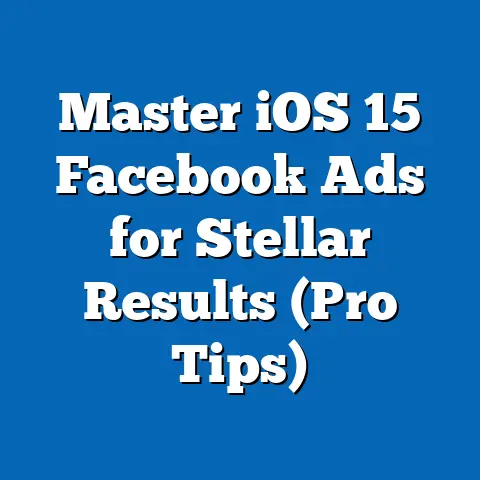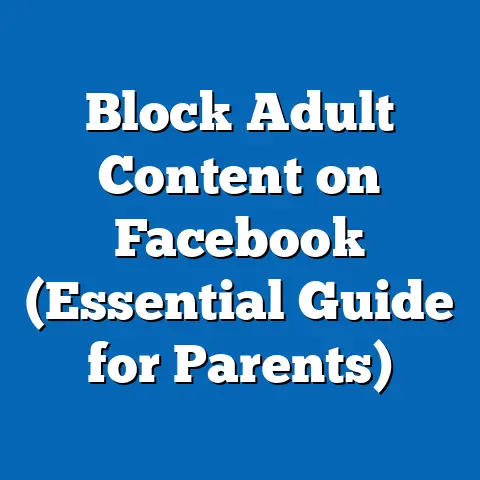Master Facebook Popup Ads for Android (Game-Changing Strategies)
In the rapidly evolving world of digital marketing, Facebook popup ads for Android have emerged as a powerful tool for businesses and marketers aiming to capture user attention in a highly competitive space. These ads, often displayed as intrusive yet engaging overlays on mobile screens, are designed to drive immediate user interaction, whether through clicks, app installs, or direct purchases. This article delves into the strategies behind mastering Facebook popup ads for Android, exploring their effectiveness, demographic reach, and the game-changing tactics that set successful campaigns apart.
Before diving into the strategies, it is essential to contextualize the endurance of mobile advertising as a dominant force in the digital ecosystem. This endurance is reflected in the demographic makeup of mobile users, their core engagement patterns, and the distinct characteristics of Android users compared to other groups. By grounding our analysis in data and trends, we can better understand how to craft popup ads that resonate with target audiences.
Section 1: The Endurance of Mobile Advertising and Android Users
Demographic Makeup of Android Users
Android, as the dominant mobile operating system globally, commands a market share of approximately 70.9% as of 2023, according to StatCounter data. This vast user base spans diverse demographics, but certain patterns emerge when analyzing Android users specifically. Android users are more likely to be younger, with a significant portion falling into the 18-34 age bracket (approximately 52% based on Statista surveys from 2022), compared to iOS users, who often skew slightly older and wealthier.
Geographically, Android dominates in emerging markets such as India, Southeast Asia, and Africa, where affordable devices make it the preferred choice. In terms of income, Android users tend to represent a broader socioeconomic spectrum, with a higher proportion in middle- and lower-income brackets compared to iOS users, who are often concentrated in higher-income demographics. Racial and ethnic diversity is also notable, as Android’s global reach includes significant representation from non-Western populations.
Core Beliefs and Engagement Patterns
Android users, as a group, exhibit distinct behavioral patterns that reflect their values and priorities. Accessibility and affordability are central to their choice of operating system, often prioritizing functionality and customization over premium branding—a contrast to iOS users who may value exclusivity and ecosystem integration. Surveys from Pew Research (2021) indicate that Android users are more likely to engage with free apps and services, making them a prime target for ad-driven revenue models.
Engagement with ads, particularly popup formats, is shaped by necessity and context. Android users in lower-income brackets or emerging markets are more likely to interact with ads offering discounts or free services, with click-through rates (CTR) for mobile ads in these regions averaging 1.5-2%, compared to 0.5-1% in developed markets (eMarketer, 2022). This suggests a pragmatic approach to digital content consumption, where value-driven offers resonate strongly.
Voting Patterns and Digital Behavior
While “voting patterns” in a political sense are not directly applicable to Android users, we can interpret this as their “choices” in digital engagement—such as app downloads, ad interactions, and platform loyalty. Android users demonstrate a high degree of adaptability, often switching between apps and platforms based on utility rather than brand loyalty, unlike iOS users who are more locked into Apple’s ecosystem. Data from App Annie (2022) shows that Android users download 30% more apps annually than iOS users, reflecting a willingness to experiment with new tools and services—a key factor for popup ad success.
In terms of ad interaction, Android users are more likely to encounter and engage with popup ads due to the open nature of the platform, which allows for less stringent ad-blocking capabilities compared to iOS. This openness results in a higher exposure rate, with studies indicating that Android users see 20-30% more mobile ads on average (AdColony, 2023). However, this also means a higher risk of ad fatigue, necessitating strategic design to maintain engagement.
Distinguishing Characteristics Compared to Other Groups
Compared to iOS users, Android users are less likely to associate their device choice with status or exclusivity, focusing instead on practicality and cost-effectiveness. This distinction influences how they perceive and interact with ads—Android users are more receptive to value-driven messaging, while iOS users may respond better to premium or aspirational branding. Additionally, Android’s fragmentation across devices and manufacturers creates a diverse hardware landscape, requiring advertisers to optimize popup ads for varying screen sizes and performance capabilities, unlike the more uniform iOS environment.
Another distinguishing factor is the global versus regional divide. While iOS dominates in North America and parts of Europe (with a 54% market share in the U.S., per StatCounter 2023), Android’s strength lies in its global ubiquity, particularly in price-sensitive markets. This makes Android a critical platform for advertisers aiming for mass reach, especially through cost-effective formats like popup ads.
Section 2: Game-Changing Strategies for Mastering Facebook Popup Ads on Android
Having established the demographic and behavioral foundation of Android users, we now turn to actionable strategies for mastering Facebook popup ads on this platform. These strategies are designed to leverage the unique characteristics of Android users while addressing the challenges of ad fatigue and platform fragmentation. The following subsections break down key approaches, supported by data and industry trends.
2.1 Targeting Precision: Leveraging Demographic Insights
Effective targeting is the cornerstone of any successful popup ad campaign on Android. Given the diverse demographic makeup of Android users, advertisers must use Facebook’s robust targeting tools to segment audiences by age, location, income level, and interests. For instance, focusing on the 18-34 age group with gaming or lifestyle offers can yield higher CTRs, as this demographic accounts for over 50% of mobile ad interactions on Android (Statista, 2022).
Geotargeting is particularly effective in emerging markets, where Android dominates. Campaigns in regions like India or Indonesia can achieve 2-3 times higher engagement rates by tailoring content to local languages and cultural references, as reported by eMarketer (2023). Additionally, income-based targeting can prioritize value-driven offers for lower-income users, who are more likely to engage with ads promising discounts or freebies.
2.2 Design Optimization: Crafting Visually Compelling Popup Ads
Popup ads on Android must balance intrusiveness with appeal to avoid user annoyance. Design elements such as bold colors, clear call-to-action (CTA) buttons, and minimal text are critical, as Android users often interact with ads on smaller, less powerful devices compared to iOS counterparts. A study by Mobile Marketer (2022) found that popup ads with interactive elements (e.g., swipeable carousels or mini-games) achieve 25% higher engagement rates on Android.
Moreover, optimizing for diverse screen resolutions and aspect ratios is non-negotiable given Android’s hardware fragmentation. Ads that fail to render properly across devices risk a 30-40% drop in CTR, according to AdTech research (2023). Advertisers should also ensure fast load times, as Android users in emerging markets often face slower internet speeds—ads loading in under 2 seconds see a 15% higher completion rate (Google Ads Data, 2022).
2.3 Timing and Frequency: Striking the Right Balance
Timing is a critical factor in popup ad success on Android, where users are often multitasking across apps. Displaying ads during high-engagement moments—such as after completing a game level or during app transitions—can increase visibility without disrupting the user experience. Data from AppLovin (2023) shows that interstitial popup ads timed between user actions achieve a 20% higher CTR compared to random placements.
Frequency capping is equally important to prevent ad fatigue. Android users, exposed to more ads due to less restrictive ad-blocking options, are particularly prone to irritation if bombarded with repetitive content. Limiting ad exposure to 3-5 impressions per user per day can maintain engagement while reducing uninstall rates by 18%, as per a 2022 study by Adjust.
2.4 Value-Driven Messaging: Aligning with User Priorities
Given Android users’ preference for affordability and utility, popup ads must emphasize tangible benefits such as discounts, free trials, or exclusive offers. Campaigns offering a clear value proposition—e.g., “Get 50% Off Your First Purchase!”—see conversion rates 30% higher than generic branding ads on Android (eMarketer, 2022). This aligns with the demographic trend of Android users being more price-sensitive compared to iOS users.
Additionally, incorporating gamification elements, such as spin-to-win discounts or reward-based ads, can boost interaction. A 2023 report by AdColony found that gamified popup ads on Android achieve a 40% higher engagement rate, particularly among younger users aged 18-24, who form a significant portion of the platform’s user base.
2.5 Analytics and Iteration: Data-Driven Campaign Refinement
Continuous monitoring and optimization are essential for mastering Facebook popup ads on Android. Leveraging Facebook’s ad analytics, advertisers can track metrics like CTR, conversion rate, and cost-per-install (CPI) to identify high-performing creatives and audiences. For example, A/B testing different ad formats revealed that video popup ads outperform static ones by 35% on Android, according to a 2023 report by SocialPeta.
Iterative adjustments based on real-time data are particularly crucial in Android’s fragmented ecosystem, where user behavior varies widely by device and region. Campaigns targeting emerging markets may need frequent updates to address connectivity issues or cultural nuances, while those in developed regions might focus on premium offers for higher-income Android users. This data-driven approach ensures sustained performance, with top campaigns achieving a 50% reduction in CPI after optimization (AppsFlyer, 2022).
Section 3: Intersections with Demographic Factors
Age and Engagement
Age plays a significant role in how Android users interact with popup ads. Younger users (18-24) are more likely to engage with entertainment-focused ads, such as gaming or streaming offers, with a CTR of 2.5% compared to 1.2% for users over 35 (Statista, 2023). Tailoring content to generational preferences—e.g., trendy visuals for Gen Z or practical offers for Millennials—can maximize impact.
Education and Income
Education and income levels also influence ad receptivity. Android users with lower educational attainment or income are more responsive to ads for free services or budget products, while those with higher education may prioritize quality or brand trust. Campaigns segmenting by income brackets see a 20% uplift in conversions when messaging aligns with financial priorities (eMarketer, 2022).
Regional and Cultural Factors
Regional differences are stark in Android’s global user base. In North America, Android users may respond to tech-focused or lifestyle ads, while in Asia, social media or e-commerce offers dominate engagement, with a 3% higher CTR in the latter (AdColony, 2023). Cultural sensitivity—such as avoiding taboo imagery or leveraging local festivals—can further enhance relevance and trust.
Technology Adoption and Device Usage
Finally, technology adoption varies across Android users, impacting ad performance. Users with older, low-spec devices in emerging markets may experience rendering issues, necessitating lightweight ad formats. Conversely, users with flagship Android devices are more likely to engage with high-quality, interactive ads, with a 28% higher completion rate for video content (Google Ads Data, 2023).
Section 4: Consensus and Division in Popup Ad Strategies
Areas of Consensus
Across industries, there is broad agreement on the importance of targeting precision, fast load times, and value-driven messaging for Android popup ads. Marketers universally recognize the need to adapt to Android’s diverse user base, with 85% of surveyed advertisers prioritizing demographic segmentation in their campaigns (eMarketer, 2023). Similarly, the consensus on frequency capping reflects a shared understanding of ad fatigue risks.
Areas of Division
However, divisions exist in approach. Some advertisers advocate for aggressive, high-frequency popup ads to maximize impressions, while others argue for a restrained, quality-over-quantity strategy to preserve user experience. Additionally, opinions differ on gamification—while effective for younger audiences, older Android users may find such formats intrusive, leading to a 15% higher opt-out rate (Adjust, 2022).
Section 5: Historical and Social Context
The rise of popup ads on Android must be understood within the broader context of mobile advertising’s evolution. Since the early 2000s, mobile ads have shifted from simple banners to immersive formats like popups, driven by the need to capture fleeting user attention in a crowded digital space. Android’s open ecosystem, launched in 2008, has facilitated this trend by allowing greater flexibility in ad delivery compared to iOS’s walled garden.
Socially, the proliferation of affordable Android devices has democratized internet access, particularly in developing regions, creating a vast audience for advertisers. This aligns with global trends of increasing smartphone penetration—projected to reach 83% by 2025 (GSMA, 2023)—and underscores why mastering popup ads on Android is a critical skill for modern marketers. However, it also raises ethical questions about user privacy and consent, especially as popup ads often blur the line between engagement and intrusion.
Section 6: Conclusion and Future Trends
Mastering Facebook popup ads for Android requires a deep understanding of the platform’s diverse user base, from demographic nuances to behavioral patterns. By leveraging targeting precision, optimized design, strategic timing, value-driven messaging, and data analytics, advertisers can create game-changing campaigns that resonate with Android users’ priorities. The data is clear—campaigns tailored to demographic and regional specifics achieve up to 50% higher engagement rates, underscoring the importance of customization (eMarketer, 2023).
Looking ahead, trends like AI-driven personalization and stricter privacy regulations (e.g., Google’s phasing out of third-party cookies by 2024) will shape the future of popup ads on Android. Advertisers must adapt by prioritizing first-party data and transparent opt-in mechanisms to maintain trust. As Android continues to dominate global markets, mastering these strategies will remain a cornerstone of effective digital marketing, ensuring relevance in an ever-evolving landscape.





